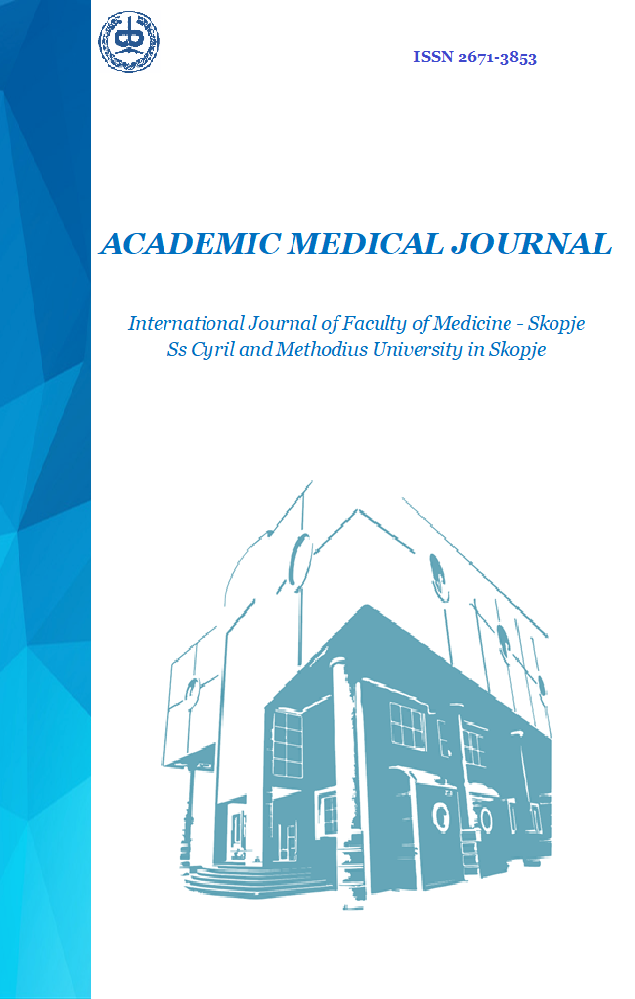EVALUATING CHRONIC RHINOSINUSITIS AS A COMORBID DRIVER IN COPD
Keywords:
Sinusitis, COPD, inflammatory markersAbstract
Introduction: Chronic rhinosinusitis (CRS) is increasingly recognized as a significant comorbidity in patients with chronic obstructive pulmonary disease (COPD), particularly under the framework of the “united airways” model, which emphasizes shared inflammatory mechanisms across the upper and lower respiratory tract.
Aim: To evaluate inflammatory biomarker profiles among COPD patients with and without CRS, and to assess differences across distinct COPD phenotypes—non-exacerbators (NE), frequent exacerbators (E), and asthma-COPD overlap (ACO).
Material and methods: A cross-sectional study was conducted on 36 COPD patients at a university clinic in Skopje, including 21 with CRS and 15 patients without CRS. All participants underwent clinical phenotyping, nasal endoscopy, sinus CT, and serum biomarker analysis (IL-4, IL-5, IL-6, IL-8, CRP, leukocytes). Statistical comparisons were made using Mann–Whitney U and Kruskal–Wallis tests.
Results: CRS was predominantly found in patients with the ACO phenotype (71.4%, p = 0.0006). No statistically significant differences were observed in systemic biomarkers (IL‑4, IL‑5, IL‑6, IL‑8, CRP, leukocytes) between COPD patients with and without CRS. IL‑5 and IL‑6 were undetectable. Similarly, inflammatory profiles did not significantly differ among COPD phenotypes.
Conclusion: CRS appears disproportionately represented in the ACO phenotype, likely due to shared type‑2 inflammatory pathways. However, conventional systemic biomarkers lack the sensitivity to detect upper airway involvement or differentiate COPD phenotypes. These findings highlight the need for comprehensive airway assessment and more specific biomarkers in future studies to better understand the interplay between CRS and COPD.
References
Arndal E, Sørensen AL, Lapperre TS, Said N, Trampedach C, Aanæs K, Alanin MC, Christensen KB, Backer V, von Buchwald C. Chronic rhinosinusitis in COPD: A prevalent but unrecognized comorbidity impacting health related quality of life. Respir Med 2020; 171: 106092. doi: 10.1016/j.rmed.2020.106092.
Kim JS, Rubin BK. Nasal and sinus inflammation in chronic obstructive pulmonary disease. COPD. 2007; 4(2): 163-166. doi: 10.1080/15412550701341228.
Øie MR, Helvik AS, Sue-Chu M, Steinsvåg SK, Thorstensen WM. Sinonasal Symptoms in COPD: Burden and Associations with Clinical Markers of Disease. Int J Chron Obstruct Pulmon Dis 2022; 17: 2137-2147. doi: 10.2147/COPD.S372991. Erratum in: Int J Chron Obstruct Pulmon Dis. 2022 Oct 28;17:2789-2790. doi: 10.2147/COPD.S392892.
Caminha GP, Pizzichini E, Lubianca Neto JF, Hopkins C, Moreira JDS, Pizzichini MMM. Rhinosinusitis symptoms, smoking and COPD: Prevalence and associations. Clin Otolaryngol 2018; 43(6): 1560-1565. doi: 10.1111/coa.13215.
Deosthale NV, Khadakkar SP, Harkare VV, Dhoke PR, Dhote KS, Soni AJ, et al. Diagnostic Accuracy of Nasal Endoscopy as Compared to Computed Tomography in Chronic Rhinosinusitis. Indian J Otolaryngol Head Neck Surg 2017; 69(4):494-499. doi: 10.1007/s12070-017-1232-0.
Yii ACA, Tay TR, Choo XN, Koh MSY, Tee AKH, Wang DY. Precision medicine in united airways disease: A "treatable traits" approach. Allergy 2018; 73(10): 1964-1978. doi: 10.1111/all.13496.
Håkansson K, von Buchwald C, Thomsen SF, Thyssen JP, Backer V, Linneberg A. Nonallergic rhinitis and its association with smoking and lower airway disease: A general population study. Am J Rhinol Allergy 2011; 25(1): 25-29. doi: 10.2500/ajra.2011.25.3556.
Stockley RA, Halpin DMG, Celli BR, Singh D. Chronic obstructive pulmonary disease biomarkers and their interpretation. Am J Respir Crit Care Med 2019; 199(10): 1195-1204. doi: 10.1164/rccm.201810-1860SO.
Pantazopoulos I, Magounaki K, Kotsiou O, Rouka E, Perlikos F, Kakavas S, et al. Incorporating Biomarkers in COPD Management: The Research Keeps Going. J Pers Med 2022; 12(3): 379. doi: 10.3390/jpm12030379.
Gonçalves I, Guimarães MJ, van Zeller M, Menezes F, Moita J, Simão P. Clinical and molecular markers in COPD. Pulmonology 2018; 24(4): 250-259. doi: 10.1016/j.pulmoe.2018.02.005.
Fokkens WJ, Lund VJ, Mullol J, Bachert C, Alobid I, Baroody F, et al. EPOS 2012: European position paper on rhinosinusitis and nasal polyps 2012. A summary for otorhinolaryngologists. Rhinology 2012; 50(1): 1-12. doi: 10.4193/Rhino12.000.
Hosseini M, Almasi-Hashiani A, Sepidarkish M, Maroufizadeh S. Global prevalence of asthma-COPD overlap (ACO) in the general population: a systematic review and meta-analysis. Respir Res 2019; 20(1): 229. doi: 10.1186/s12931-019-1198-4.
Kobayashi S, Hanagama M, Ishida M, Ono M, Sato H, Yamanda S, et al. Clinical Characteristics and Outcomes of Patients with Asthma-COPD Overlap in Japanese Patients with COPD. Int J Chron Obstruct Pulmon Dis 2020; 15: 2923-2929. doi: 10.2147/COPD.S276314.
Su B, Liu T, Fan H, Chen F, Ding H, Wu Z, et al. Inflammatory Markers and the Risk of Chronic Obstructive Pulmonary Disease: A Systematic Review and Meta-Analysis. PLoS One 2016; 11(4): e0150586. doi: 10.1371/journal.pone.0150586.
Pease JE, Sabroe I. The role of interleukin-8 and its receptors in inflammatory lung disease: implications for therapy. Am J Respir Med 2002; 1(1): 19-25. doi: 10.1007/BF03257159.
King PT. Inflammation in chronic obstructive pulmonary disease and its role in cardiovascular disease and lung cancer. Clin Transl Med 2015; 4(1): 68. doi: 10.1186/s40169-015-0068-z.
Wouters EF, Groenewegen KH, Dentener MA, Vernooy JH. Systemic inflammation in chronic obstructive pulmonary disease: the role of exacerbations. Proc Am Thorac Soc 2007; 4(8): 626-634. doi: 10.1513/pats.200706-071TH.
Yıldırım YS, Apuhan T, Koçoğlu E, Simşek T, Kazaz H. High sensitivity C-reactive protein levels in chronic rhinosinusitis and allergic rhinitis. Kulak Burun Bogaz Ihtis Derg 2011; 21(5): 266-269. doi: 10.5606/kbbihtisas.2011.039.
Aksu F, Capan N, Aksu K, Ofluoğlu R, Canbakan S, Yavuz B, Akin KO. C-reactive protein levels are raised in stable Chronic obstructive pulmonary disease patients independent of smoking behavior and biomass exposure. J Thorac Dis 2013; 5(4): 414-421. doi: 10.3978/j.issn.2072-1439.2013.06.27.
Wei J, Xiong XF, Lin YH, Zheng BX, Cheng DY. Association between serum interleukin-6 concentrations and chronic obstructive pulmonary disease: a systematic review and meta-analysis. PeerJ 2015; 3: e1199. doi: 10.7717/peerj.1199.
Agustí A, Edwards LD, Rennard SI, MacNee W, Tal-Singer R, Miller BE, et al. Evaluation of COPD Longitudinally to Identify Predictive Surrogate Endpoints (ECLIPSE) Investigators. Persistent systemic inflammation is associated with poor clinical outcomes in COPD: a novel phenotype. PLoS One 2012; 7(5): e37483. doi: 10.1371/journal.pone.0037483.
Sonar M, Jayadeva BT, Shashibhushan BL. Comparative Study of Systemic Inflammatory Markers in Clinical Phenotypes of Chronic Obstructive Pulmonary Disease. Tanaffos 2023; 22(2): 215-220. PMID: 38628879.
Downloads
Published
Issue
Section
License
This work is licensed under CC BY 4.0 





